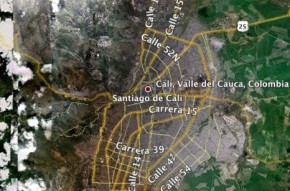
By Lauren O’Reilly
The district of Aguablanca is located on 3,000 hectares in the southeastern floodplain (Ridgley, 1989) of Columbia’s third largest city, Santiago de Cali (Dávila, 2002). As of 2002, 567,000 of the city’s 2.3 million inhabitants (Lauzon & Parkinson, 2008) lived in this low-lying, flood prone area (Dávila, 2002). Cali has a population density of 156 inhabitants per hectare and experiences population growth due to 45% in-migration from the Pacific coast (World Bank, 2002). The non-poor tend to reside in the central foothills of the western cordillera mountain chain, closer to Cali’s central business district, (Lauzon & Parkinson, 2008), creating a spatial socio-economic divide. Aguablanca is characterized by the highest rates of violence in the city (Harpham et al., 2004), a high unemployment rate at 26% (2000) (Lauzon & Parkinson, 2008), and approximately 27% of inhabitants live in poverty on less than 3.20 USD a day (Harpham et al., 2004). Main employment sector’s include manufacturing, commerce, and services (Dávila, 2002), but most district residents receive income from informal, self-employment or remittance payments from family members (Lauzon & Parkinson, 2008).
The majority of city residents have access to electricity, garbage collection, and public water supply, but the poor are more likely to share a water tap (30.3% of the lowest income group) and toilet with neighboring households, sometimes leading to unsanitary conditions and subsequent health risks (World Bank, 2002). In the poorest communas less than half the residents have access to potable water and sewage (Dávila, 2002). Informal settlement has resulted in these basic service deficiencies. Households have shared, illegal pipe connections to water mains and build hand-dug latrines, which often fill quickly due to the high water table in the area. In the case of Comueros II, a resident installed a sewer system by purchasing used pipes from the city’s utility company, EMCALI, and draining the sewage into the Laguna El Pondaje (Ridgley, 1989). Untreated wastewater disposal, along with industrial activities, has led the city to rank environmental pollution as the second most important issue after the drinking water supply, Cauca River (CINARA, 2009).
After large population growth in Aguablanca in the mid 1980’s, the local government’s planning authority resisted incorporating these areas as urban residential land use. Because of the high risk for natural flooding from the Cauca River this would have provided legal infrastructure (D’vila, 2002). Informal settlement in this region, particularly along the marginal river, is a public health risk to both those inhabiting the area and the city population since it pollutes the water supply (CINARA, 2010).
A recommended policy involves a water management upgrading initiative that requires multiple steps, first beginning with a combined survey project and public information campaign under the direction of Administrative Department of Municipal Planning (DAPM) in collaboration with the public service utility, EMCALI. Collection of information and mapping of the existing infrastructure and settlements in the areas closest to the river would allow for the establishment of a buffer zone. This would be reported to the Administrative Department of Environmental Management (DAGMA) for discussion between the three administrative divisions and potentially propose settlement violations for development in these regions. Households located within the boundary zone would be candidates for relocation, with the help of government aid. The information collected will also be used to evaluate which water infrastructure can remain in place and then be upgraded. Various public involvement meetings with community members will be held to evaluate the needs of the district and to inform the public about the project and the potential for relocation. After the assessment is conducted and discussed between the three administrative divisions, the next phase of the project can begin planning to request federal funding and assistance to begin a low-income housing project.
References
CINARA. (2009). Cali, A Demonstration City. Wastewater Management Framework for the city of Cali, Colombia. A paradigm shift in the wastewater pollution control. Sustainable Water Improve Tomorrow’s Cities’ Health ‘ SWITCH Project. Retreived from http://switchcali.files.wordpress.com/2008/06/wastewater-management-framework-of-cali.pdf
CINARA. (2010). Deliverable D1.1.6. Decontamination and recuperation of water resources in the Municipality of Cali, Colombia. A Strategic Direction. Sustainable Water Improve Tomorrow’s Cities’ Health ‘ SWITCH Project. Retreived from http://www.switchurbanwater.eu/outputs/pdfs/W1-1_CCAL_RPT_D1.1.6_Strategic_Planning_Process_-_Cali.pdf
Dávila, J.D. (2002). Urban Poverty Reduction Experiences in Cali, Colombia: Lessons from the Work of Local Non-profit Organisations Human Settlements Working Paper Series Poverty Reduction in Urban Areas No. 4. IIED, London. Retrieved from http://pubs.iied.org/9077IIED.html?b=t.
Google. (2012). Google Earth (Version 6.0.3.2197) [Software]. Available from http://www.earth.google.com
Harpham, T., Grant, E. & Rodriguez, C. (2003). Mental Health and social capital in Cali, Colombia. Social Science & Medicine, 58, 2267-2277. Retrieved from http://clubderevistasgruposaludmental.bligoo.com.co/media/users/8/414696/files/30728/mental_health_and_social_capital_cali.pdf
Hentschel, J. (2004). Using Rapid City Surveys to Inform Municipal Social Policy ‘ An Application in Cali, Colombia. WPS 3369. Retrieved from http://siteresources.worldbank.org/INTLACREGTOPURBDEV/FeaturedTopics/20849123/CaliColombiaWorkingPaper.pdf
Lauzon, A.C., & Parkinson, S. (2008). The Impact of the Internet on Local Social Equity: A Study of a Telecenter in Aguablanca, Columbia. Information Technologies and International Development, 4, 3, 21-38. Retrieved from http://itidjournal.org/itid/article/viewFile/300/132.
Rigdley, M. (1989). Services in a Columbian Shantytown: Speculations on the Limits of Collective Self-Help. Retrieved from http://sites.maxwell.syr.edu/clag/yearbook1989/ridgley.pdf
World Bank. (2002). Cali Columbia: Toward a City Development Strategy. Washington, DC.
This article is a product of Professor Shagun Mehrotra’s Global Urban Environmental Policy class. Views expressed are entirely those of the individual author.